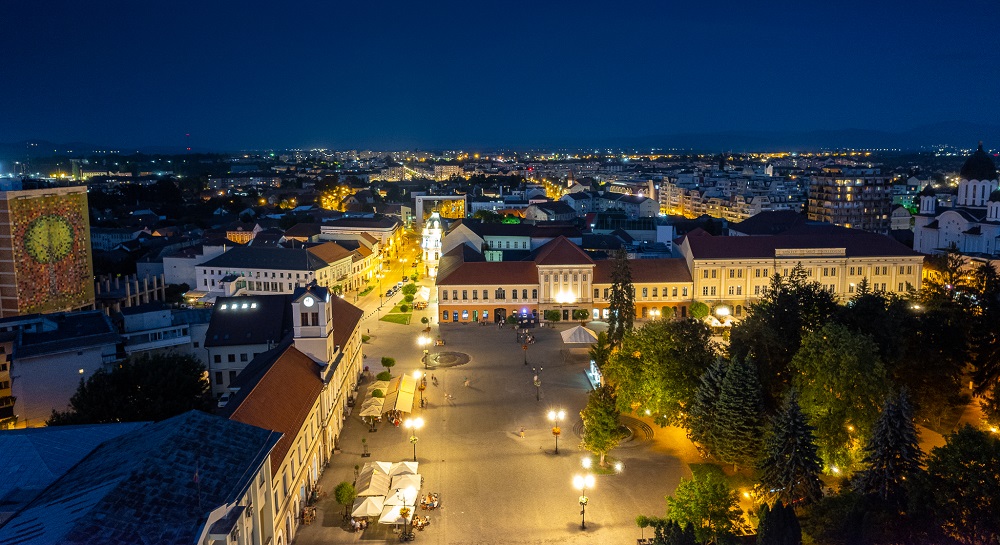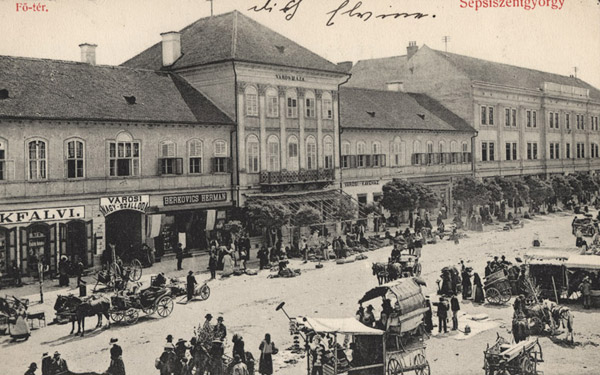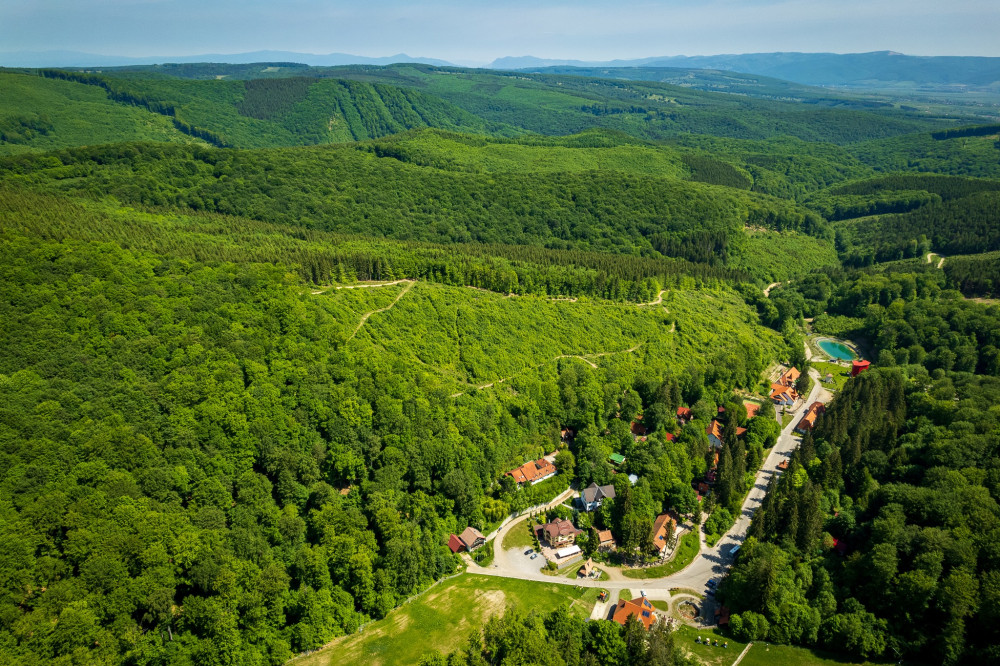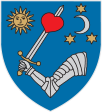Local history
SFÂNTU GHEORGHE

Sfântu Gheorghe at night (Source: Municipality of Sfântu Gheorghe)
It is the county town of Covasna county and it was also the chief town of the former Háromszék county. It is situated in the meeting zone of the Baraolt Mountains and the depression of Sfântu Gheorghe, ”slightly eccentric” in the middle and southern parts of the county, on both banks of the Olt River, on an altitude above sea-level of 525-580 meters. It lies on a 12 square kms area, its administrative territory also contains some small settlements: Chilieni (in a 2 kms distance from the town), Coseni (in a 3 kms distance) and Sugas-Bai, the health resort of the town lying in the heart of the Baraolt Mountains (in a 9 kms distance). It has developed from the early medieval village named Szentgyörgyfalva, its name originates from the patron saint of its old catholic church with fortification. On its territory arhaeologists have excavated several settlements dated from the neolithic age. There are also present the culture of the Bronze Age's human and the remnants of the Iron Age's civilization. Traces of medieval settlements from the 10-12th centuries were discovered in Várgödre and ones from the 12th century in Bedeháza. The material proofs are kept in the Szekler National Museum of the town.
The place was first mentioned in document in 1332, namely in the papal memoranda of the tithes where was named Sancto Georgio. It had an independent parish and the priest has payed much rates. As a town it was first mentioned in 1461 in a document sent out by Székely Bálint, the sub-prefect of the Szeklers. In a letter written in 1462 by Báthori István it appears as a privileged town. In 1880 it was merged with with a settlement situated southwards, namely Simeria. Today it is an organic part of the town. In 1407 it appears under the name of Zenth Maria. This name has turned into Simeria throughout ages. Chilieni was first mentioned in written documents in 1334 (Kylien), Coşeni in 1448 (Zwthyor). During the reigns of Bethlen Gábor and Rákóczi György the 1st this small town started to develop. The attack of the Tartars in 1658 was a real affliction in its history. It was set on fire, the population hidden in the castle was massacred. The attack in 1661 caused a similar destruction, 500 people died and almost 1000 were carried off. Neither the later Hapsburg reign has brought better times, the dissatisfactions resulted in the outbreak of the war of independence led by Thököly Imre. Its failure has been followed by mourning, the maintenance of the mercenary force was difficult. This situation has led to the organization of the aggressive frontier guards' system under the rule of Maria Theresa. Sfîntu Gheorghe became the centre of the frontier guard's headquarter.
The economical development of the town was restrained in a way by the closeness of Braşov and Târgu Secuiesc. Its system of guild has been set up only in the first part of the 19th century. The road for trade which followed the valley of the Olt River in north-southern direction was to its advantage. It has kept its agrarian character for a long time. It was an important place of fairs. Its nationwide fair was allowed by Lajos the 2nd in 1520. One of the most glorious periods of its history was the time of the Hungarian War of Independence and revolution in 1848-49. In its House was declared the necessity of the armed fight of self-defence. This was the place where Gábor Áron announced: „We will have cannons!" and where the movement of conspiracy led by Makk found understanding in 1854. Both movements' aim was the armed overthrow of the Hapsburg opression. Both have been followed by mourning and bondage. In 1854 here were hanged on gallows Váradi József and Bartalis Ferenc Szekler martyrs.

Main square in 1800s (Source:www.sepsiszentgyorgy.info)
After the war of independence has started the developement of the economy and of the small industry. Distillery was built in 1853, brewery in 1857. In 1876 Trei Scaune county came into being and this caused another rate of progress. In 1879 started a weaving mill, in 1899 a cigarette factory. In 1891 the circular railway like between Braşov and Sfântu Gheorghe was built, in 1908 started the delivery of the electric light. Also in this time appeared the first institutions of general education and culture: the printing-house (1874), the Szekler National Museum (1879) and the „Székely Mikó" College (1893) which functions even today. After 1948 the town has a constant theatrical company.
From the last third of the 19th century it has a permanent newspaper. In the first part of the 20th century, mainly after the reorganization of the country in 1968 the town has become a powerful industrial centre. Electromotor factory, works producing auto parts, plastic factory, woodworking factories have started up.
Today it has several new economical units based on private ownership. It has two sports courts, a swimming-bath, a supermarket, it give place to several colleges and academical field-faculties. The continuous economical development resulted in the growing of the town's population. According to the last census from 2002 it has 61.543 inhabitants out of which 74,92% are Szekler-Hungarians, 23,03% Romanians, 1,51 % Roms, 0,20% Germans and Saxons, 0,11% Csángós, 0,23% are of other nationalities. Chilieni has 655 inhabitants; Coşeni has 499 out of which most are of Hungarian nationality.
Sfîntu Gheorghe is a remarkable town not only from the economical point of view but it is also an important cultural centre and it has a considerable touristical seducement, it is the scene of the more and more increasing tourism. The Szekler National Museum has not only an archaeological-historical department and one about 1848 but also a department of natural sciences and one of etnography. Here we can admire Diószegi László's famous collection of butterflies.
The art gallery of the town can also count on our interest, here are kept the works of classics such as Barabás Miklós, Sikó Miklós and Gyárfás Jenő. Its historic buildings increase its touristical value. Several monuments, statues and plaques speak about the artistical works of the past centuries and the modern times. So are the reformed church (14-16th centuries), the unitarian church (13-15th centuries) and the Székely-Potsa-mansion in Chilieni, the classicist house of the Nagy family and the small bell with caption (dated from 1426) of the reformed church in Coşeni, the Bora-mansion in Simeria (1750), the so-called Lábasház in Sfântu Gheorghe (1820-21), the county hall (1832), the Bazaar (1867-73), the "Mihai Viteazul" grammar school (1908-10), the buildings designed by Kós Károly (Szekler National Museum, Kós Károly school, the Csulak-house, the Reformed popular school, the Keresztes-house, all from the period between 1911-30. Several famous people are honoured here by statues, such as Dózsa György (the work of Kulcsár Béla Jr.), count Mikó Imre (Bocskai Vince), Gábor Áron and Nicolae Bălcescu (Gergely István and Izsák Márton),. Mikes Kelemen (Vetró András), Kós Károly (Benczédi Sándor), Mihai Viteazul (Gheorghe Rădulescu Gir).


